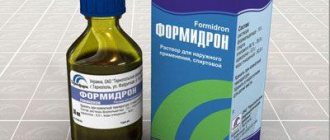An alternative name for vitamin B5 is pantothenic acid, which is one of the most important compounds directly involved in metabolic processes during the breakdown of proteins, fats and carbohydrates. Like other B vitamins, pantothenic acid is a water-soluble organic compound that cannot accumulate in the internal environment. You can always buy vitamins in our pharmacy.
Historical information
The discovery of pantothenic acid is associated with the study of “bios” - a group of substances of natural origin that have a stimulating effect on the growth of yeast.
When dividing the “bios” into individual substances, along with inositol, thiamine and biotin, a thermolabile substance of an acidic nature, which is not adsorbed by coal, was isolated, which is necessary for the growth of yeast. While studying this substance, Williams in 1933 discovered that it is extremely widespread in nature, which is why the name “pantothenic acid” (Greek for “ubiquitous”) was proposed. As a result of research carried out from 1933 to 1939, Williams and co-workers were able to isolate this substance from liver extracts in a highly purified state, in the form of a crystalline calcium salt. In 1940, they deciphered the chemical structure of pantothenic acid, which was soon confirmed by its synthesis. At the same time, it was found that liver extract, freed from vitamins B1, B2 and B6 by adsorption on charcoal, cures dermatitis that develops in chickens when fed with heated feed. The antidermatitis factor contained in the extract was given the name vitamin G. Further study of this factor showed that it is identical to pantothenic acid. To clarify the role of pantothenic acid in metabolism and the mechanism of its action, Lipman's discovery of coenzyme A (CoA, acetylation coenzyme), which includes pantothenic acid, was extremely important.
general information
The first mention of the substance dates back to 1933, when American biochemist John Williams isolated a previously unknown nutrient from yeast. The active compound was named vitamin B5. Research into the molecule continued, and in 1940, chemists from the German company Merck isolated the substance in its pure form and studied in detail the structure and chemistry of the bonds. Later, vitamins B5 began to be called pantothenic acid. The name comes from a Greek word that means “omnipresent,” as the compound has been found in many animal and plant foods.
— 46%
Jarrow Formulas, Pantothenic Acid B5, 500 mg, 100 Veggie Caps
873 rub. 471 rub.
More details
Vitamin B5 continued to be studied in 1953, when scientists discovered coenzyme A, an essential component of almost all biochemical reactions in cells. This coenzyme is synthesized with the participation of pantothenate and the amino acid cysteine. After this discovery, doctors became interested in the properties of vitamin B5 and began to actively use it for medical purposes.
Chemical and physical properties
Chemically, natural pantothenic acid is D (+)-a,g-dioxy-b,b-dimethylbutyryl-M-amide of b-aminopropionic acid and consists of Da,g-dioxy-b,b-dimethylbutyric (pantothenic) acid residues and b-alanine linked by an amide bond. The empirical formula of pantothenic acid is C6H17O5N; molecular weight - 219. Pantothenic acid has one asymmetric carbon atom, and therefore it can exist in the form of two optically active isomers or in the form of an optically inactive reccemate. Natural D-(+)-pantothenic acid, which is a vitamin, rotates the plane of polarization of light to the right: D25 = +37.5° (water).
An optically neutral recemate containing equal amounts of D (+) and L (-) isomers has only half the vitamin activity of natural pantothenic acid. D(+)-pantothenic acid is a light yellow viscous substance with a melting point of 75-80°C. It is easily soluble in water, ethyl alcohol and acetic acid, poorly soluble in higher alcohols, such as amyl alcohol, and in ether, and practically insoluble in chloroform, benzene and many other organic solvents. Pantothenic acid forms colorless crystalline salts that are highly soluble in water: sodium (melting point 121-122°C) and calcium (melting point 193.5-195°C), in the form of which it is mainly used. Pantothenic acid is thermolabile. It is especially unstable when heated in solutions of acids or alkalis, hydrolyzing at the amide bond to release b-alanine and a,g-dioxy-b,b-dimethylbutyric acid lactone (pantolactone). In neutral solutions, pantothenic acid is relatively stable. Its salts are even more stable.
Derivatives of pantothenic acid are its amide - pantothenamide, as well as pantothenol, which is formed when the carboxyl group of pantothenic acid is replaced with an alcoholic one. The latter compound is an antagonist of pantothenic acid for a number of microorganisms, but has high vitamin activity for animals, which is obviously due to its ability to be converted into pantothenic acid in the body. Of other pantothenic acid derivatives, panthetheine, which is formed by the reaction of pantothenic acid with b-mercaptoethylamine (cysteamine), is of great importance. In the form of panthetheine, pantothenic acid is part of coenzyme A. When panthetheine is oxidized, the latter turns into disulfite - pantethine.
The most important derivative of pantothenic acid is coenzyme A (CoA), in the form of which this acid performs its specific function in metabolism. Coenzyme A accounts for the majority of pantothenic acid present in animal tissues. Chemically, coenzyme A (CoA) is a nucleotide in which adenosine-3-phosphate is linked through a pyrophosphate group to pantethine.
The biological activity of pantothenic acid is closely related to the characteristics of its chemical structure. As already noted, only the natural, dextrorotatory D(+)-isomer of pantothenic acid has vitamin activity, while its optical antipode, L(-)-pantothenic acid, is devoid of biological activity. In addition to D(+)-pantothenic acid itself, only its salts and esters at the carboxyl group have biological activity, for example, ethyl ester of pantothenic acid, etc., which undergo hydrolysis in the body by esterases with the release of free pantothenic acid.
Any other structural changes in the pantothenic acid molecule, except those affecting the carboxyl group, lead to the deprivation of vitamin activity or the formation of pantothenic acid antagonists. Thus, esters of pantothenic acid at hydroxyl groups, for example the corresponding acetates, are inactive. The biological activity of pantothenic acid occurs only in the presence of both free hydroxyl and methyl groups.
Of the pantothenic acid analogues that have antivitamin properties, the best known is w-methylpantothenic acid, which has an extra methyl group. The mechanism of action of most pantothenic acid antagonists is that they, by competing with this acid, block the formation of coenzyme A. In addition, some of these compounds, for example bd-pantoylaminoethanethiol, compete with coenzyme A itself, thereby disrupting the biochemical reactions it catalyzes . Pantothenic acid is obtained synthetically by condensation of a,g-dioxy-b,b-dimethylbutyric acid or its lactone (pantolactone) with b-alanine.
Distribution of pantothenic acid in nature
Pantothenic acid is extremely widespread in nature. It is synthesized by green plants and microorganisms: yeast, many bacteria, including the intestinal flora of mammals, and fungi. Animal tissues are incapable of synthesizing pantothenic acid, but they synthesize coenzyme A from it. Pantothenic acid is found in almost all products of animal or plant origin. Animal livers, kidneys, egg yolks, caviar, and meat are especially rich in it. Vegetables rich in pantothenic acid include cauliflower, potatoes, and tomatoes. The concentration of pantothenic acid is very high in the so-called royal jelly of bees (up to 50 mg%) and brewer's yeast (14-35 mg%). Data on the content of pantothenic acid in various products are presented in the table.
Pantothenic acid content in food products
| Product | Pantothenic acid content in mg per 100 g | Product | Pantothenic acid content in mg per 100 g |
| Whole cereal grain | |||
| Meat (veal, beef, lamb) | 0,5—1,5 | Rye | 1,0—1,4 |
| Chicken meat | 0,5—0,65 | Wheat | 1,0—1,3 |
| Beef liver | 4,0—9,0 | Rice | 1,7—2,1 |
| Beef kidneys | 2,5—4,0 | Buckwheat | 2,6 |
| Eggs | 1,4—2,7 | Barley | 1,0 |
| Egg yolk | 2,7—7,0 | Oats | 2,5 |
| Milk | 0,3 | Wheat flour | 0,2—0,35 |
| Herring | 0,93—0,95 | Dried peas | 2,1—2,8 |
| Cod | 1,6 | Potato | 0,32—0,65 |
| Navaga | 0,2 | Cabbage | 0,18—0,8 |
| Halibut | 0,15 | Cauliflower | 0,92—1,0 |
| Sardines | 0,1—0,23 | Tomatoes | 0,1—0,37 |
| Fruits and berries | 0,06-0,25 |
During cooking, about 30% of pantothenic acid is lost, but part of this loss is caused not by destruction, but by transfer into the water in which the product is cooked.
METABOLISM OF VITAMIN B5
Every day, the intestinal microflora of a healthy body synthesizes 3.4 milligrams of vitamin B5. After food intake, pantothenic acid is absorbed by diffusion directly from the intestine into the blood and tissues, where it is subsequently captured by red blood cells and actively transformed into coenzyme forms - coenzyme A and phosphopantothein. The remaining part of the substance circulates in the body in a free state. The catabolism of organic compounds of non-protein nature is based on their hydrolysis, while “waste” calcium pantothenate and its metabolites are excreted in the urine.
Vitamin B5 is sensitive to heat; heat treatment of foods rich in the beneficial compound leads to a loss of 50% of the substance. It is destroyed not only under the influence of dry heat (grill, oven), but also as a result of exposure to solutions of acids and alkalis that are used in food processing, for example, during canning and freezing.
It is important to remember that pantothenic acid is found in foods exclusively in protein form and is released with the help of enzymes.
Methods for determining pantothenic acid
For the quantitative determination of pantothenic acid, microbiological methods are used, based on the fact that the growth of microorganisms that are not capable of synthesizing pantothenic acid depends on its content in the medium. Lactobacillus aradinosus or some strains of Saccharomyces cerevisiae are usually used as test organisms. Since pantothenic acid in tissues is bound in the form of coenzyme A to proteins, enzymatic methods are used to release it. Microbiological and enzymatic methods are also used to determine coenzyme A.
Pharmacological action[edit | edit code]
Administration of even large doses of pantothenic acid to experimental animals or healthy people does not cause obvious effects. Physiological functions. CoA is involved in many enzymatic reactions, including transfer reactions of acetyl (two-carbon) groups; precursor fragments of varying lengths are added to the sulfhydryl group of CoA. These reactions play an important role in carbohydrate oxidation, gluconeogenesis, fatty acid oxidation, and the synthesis of sterols, steroid hormones, and porphyrins. As part of the acyl transfer protein, pantothenic acid is involved in the synthesis of fatty acids. CoA is also involved in post-translational modification of proteins, including their N-terminal acetylation, acetylation of other amino acids, and acylation with fatty acids. Such modifications can affect the subcellular localization, stability, and activity of proteins.
Pantothenic acid metabolism
Pantothenic acid enters the human and animal body with food. In addition, in the intestines of mammals and humans, pantothenic acid is synthesized by intestinal microflora, especially E. coli. Pantothenic acid is excreted in urine and feces. Between 30 and 60% of dietary pantothenic acid is usually excreted in urine. The daily excretion of pantothenic acid in urine in humans depends on its consumption and, according to various authors, is 2.8–6.5 mg. The excretion of pantothenic acid in feces largely depends on its synthesis in the intestine. In carefully conducted studies of the balance of pantothenic acid, in a number of cases, the total amount excreted in urine and feces clearly exceeded intake from food, i.e., obviously, part of it was synthesized in the intestines. This makes it very difficult to study the balance of pantothenic acid and more accurately determine the need for it. The content of total pantothenic acid in blood serum ranges from 50 to 100 μg%. The content of pantothenic acid in different tissues of the body varies. The concentration of pantothenic acid is especially high in the liver and kidneys; it is somewhat lower in the heart muscle and skeletal muscles. In the liver of healthy people, the content of pantothenic acid ranges from 26.8 to 49.6 mcg per 1 g of tissue.
The main transformation that pantothenic acid undergoes in the body is the formation of coenzyme A. In this process, in addition to pantothenic acid, cysteine and ATP take part. The concentration of coenzyme A in the liver of an adult rat is 135 ± 8, and in the kidneys - 68 ± 9 and in brain tissue - 23 ± 4 nmol per 1 g of wet tissue. In addition, part of coenzyme A is present in tissues in the form of its esters, in particular acetyl-CoA. The concentration of the latter in rat tissues is 38 ± 2 in the liver, 11 ± 2 in the kidneys, 38 ± 6 in the heart and 8 ± 1 nmol per 1 g in the brain. In rats fed a diet devoid of pantothenic acid for 3 weeks, the latter completely disappears from the liver, kidneys, myocardium and muscles, while in the brain the content of free pantothenic acid decreases by only 35%. At the same time, the content of coenzyme A decreases in the liver by more than 10 times, and in the brain, myocardium and muscles - by 2-2.5 times.
Application in sports[edit | edit code]
Pantothenic acid, calcium pantothenate
(vitamin B5 preparation), has a powerful anabolic effect, this is facilitated by its participation in the synthesis of coenzyme A. The drug is superior in anabolic effect to all other vitamin preparations. Significantly reduces basal metabolism, which leads to rapid growth of total body weight as a result of a decrease in the proportion of oxidized proteins, lowers blood glucose levels, which promotes the release of growth hormone, increases the synthesis of acetylcholine, ATP, which increases the tone of the parasympathetic nervous system, which helps to increase the strength of the nervous system. muscular apparatus. Calcium pantothenate enhances the synthesis of steroid and other hormones and hemoglobin. It is a drug with “economizing action”, as it makes the body’s work more economical. The drug participates in the most important reactions of energy transfer and phosphorus compounds, improves liver function and promotes the removal of toxins, alcohol, poisons, and medications from the body. It has pronounced radioprotective properties, the removal of radioactive substances from the body doubles, and is characterized by a strong anti-stress effect. Calcium pantothenate promotes the absorption of potassium ions and vitamin E from the intestine, which, along with increasing the synthesis of acetylcholine, plays an important role in the process of enhancing muscle contraction.
18 highly trained runners were examined who performed treadmill work for 2 weeks. Nutrition and training loads were the same. Every day, 9 subjects took 1 g of pantothenic acid, while 9 athletes in the control group took placebo in a double-blind experiment. Statistically insignificant differences in running results, heart rate and biochemical blood parameters were established between the two groups, so it was concluded that pantothenic acid in pharmacological doses does not have a significant effect on human physical performance, although it has an anabolic effect.
Calcium pantothenate is recommended to be taken during the period of maximum training loads and during the competitive period as an anti-stress agent, especially for people who are characterized by increased anxiety. The sedative (calming) effect of calcium pantothenate is enhanced when administered with vitamin U in equal quantities.
The role of pantothenic acid in metabolism
The specific function of pantothenic acid in metabolism is that it is an essential component of coenzyme A. This coenzyme plays a fundamental role in metabolism, taking part in such biochemical processes as the oxidation and biosynthesis of fatty acids, oxidative decarboxylation of keto acids, the citric acid cycle , biosynthesis of steroids, neutral fats, phosphatides, porphyrins, synthesis of acetylcholine, acylation of aromatic amines, glucosamine, synthesis of hippuric acid and a number of other transformations. In all these processes, coenzyme A functions as an intermediate acceptor and transporter of various acidic residues (acyls), forming so-called acyl derivatives of coenzyme A (acyl-CoA). The binding of carboxylic acid residues to coenzyme A activates them. Activation is due to the fact that acyl derivatives of coenzyme A are acylthioesters in which the carboxylic acid residue is linked to the SH group of coenzyme A, an energy-rich acylthioester bond: RCO-SKoA. As a result of the formation of acyl-CoA, the carboxylic acid residue rises to a high energy level, which creates favorable thermodynamic prerequisites for its use in reactions that require energy, in particular in the acylation reactions of oxy- and amino compounds. Since the transformations of carboxylic acids that occur with the participation of CoA end with the cleavage of the acylthioether bond with the complete or partial release of its energy, this ensures that the corresponding transformations proceed in the desired direction. In addition, the formation of a thioester bond between the carboxylic acid residue and the SH group of coenzyme A increases the positive charge on the carbon atom of the acyl carbonyl group. At the same time, the mobility of the hydrogen atom in the a-position to the carbonyl increases. The first circumstance facilitates transformations by the mechanism of nucleophilic substitution at the carbonyl carbon atom (acylation reactions), the second - electrophilic reactions that occur with the elimination of a proton in the a-position, for example, the condensation of acetyl-CoA with oxaloacetic acid during the biosynthesis of citric acid, as well as carboxylation reactions, in particularly the conversion of acetyl-CoA to malonyl-CoA.
Activation of fatty acids due to the formation of acyl derivatives of CoA can occur in the animal body in several ways. One of the ways consists of direct interaction of the activated acid with CoA in the presence of ATP and Mg. These reactions, catalyzed by various thiokinases, are accompanied by the breakdown of ATP into AMP and pyrophosphate:
Mg2+
R—COOH + ATP + HS—CoA ——— R—CO—S—CoA + AMP + FFN
thiokinase
Another source of acyl derivatives of CoA are the processes of oxidative decarboxylation of a-keto acids. In this way, acetyl-CoA is formed from pyruvic acid, and succinyl-CoA is formed from a-ketoglutaric acid. If thiokinases, which activate fatty acids according to the first type, are localized in the cytoplasm of cells, then the processes of oxidative decarboxylation of keto acids, producing acetyl- and succinyl-CoA, occur in mitochondria.
The third pathway for the formation of acyl derivatives of CoA is the transfer reaction of CoA to a free acid, catalyzed by thiophorases:
R1— S— CoA + R2— COOH —-— R1- COOH + R2— CO— S— CoA
As noted above, the role of CoA and its acyl derivatives in metabolism is extremely important. A large number of different enzymatic reactions and key biochemical processes occur with their participation. Let's look at the most important of them.
Oxidation of fatty acids is the main way of breaking down fats and utilizing the energy contained in them. The first stage of the oxidative breakdown of fatty acids is the activation already described above with the formation of acyl-CoA. The fatty acid residue associated with CoA undergoes the following transformations:
- 1) dehydrogenation at the a- and b-carbon atoms, catalyzed by acyl-CoA dehydrogenase, resulting in the formation of a double bond at this position;
- 2) hydration at the double bond by the enzyme enoylhydratase, leading to the formation of b-hydroxyacyl-S-KoA;
- 3) dehydrogenation of b-hydroxyacyl-S-KoA (b-hydroxyacyl-S-CoA dehydrogenase enzyme) to form b-ketoacyl-S-KoA;
- 4) cleavage of b-ketoacyl-S-KoA by b-ketothiolase, during which acetyl-CoA is formed, and the fatty acid residue shortened by two carbon atoms is transferred to a new molecule of coenzyme A and can again repeat the described cycle of transformations. As a result of the functioning of this cycle, the fatty acid molecule undergoes oxidative cleavage with the formation of activated acetic acid residues (acetyl-CoA), which are further oxidized in the tricarboxylic acid cycle.
Synthesis of fatty acids. Since all reactions of the fatty acid oxidation cycle described above are reversible, it was initially assumed that the biosynthesis of the latter is carried out by simple reversal of oxidative reactions. In fact, in this way, only the chains of preformed fatty acids are elongated by condensing them with acetyl-CoA in the mitochondria. Complete biosynthesis of fatty acids from acetyl-CoA in the cytoplasm proceeds in a slightly different way. The main step is the carboxylation of acetyl-CoA by the biotin-containing enzyme acetyl-CoA carboxylase to form malonyl-CoA:
Mg2+
CH3-CO-SKoA + C02 + ATP —— HOOC— CH2— CO-S-KoA + ADP + H3PO4
Malonyl-CoA condenses with another molecule of acetyl-CoA. Simultaneously with condensation, decarboxylation occurs and acetoacetyl-CoA is formed, which is then reduced to butyryl-CoA due to reactions similar to the oxidation reactions of fatty acids, but proceeding in the opposite direction. Further growth of the fatty acid chain occurs through cyclic repetition of the stages of condensation of acyl-CoA with malonyl-CoA, decarboxylation and reduction of the resulting b-ketoacyl-CoA.
In addition to the biosynthesis of fatty acids, acyl derivatives of coenzyme A are involved in the formation of triglycerides, phospholipids, steroids, in particular cholesterol and steroid hormones.
Oxidative decarboxylation of a-keto acids. During the oxidative decarboxylation of a-keto acids, catalyzed by complex multienzyme complexes (see Vitamin B1), coenzyme A acts as the final acceptor of the residue of the resulting acid. In the case of oxidative decarboxylation of pyruvic acid, the end product is acetyl-K.oA, in the case of a-ketoglutaric acid, it is succinyl-CoA. The first process ensures the inclusion of pyruvic acid, which is the end product of the glycolytic breakdown of carbohydrates in animal tissues, into the tricarboxylic acid cycle, the second ensures the uninterrupted operation of this cycle, which serves as the main source of energy in most animal tissues.
The synthesis of citric acid occurs by condensation of acetyl-CoA with oxaloacetic acid.
This reaction occupies one of the key positions in the general system of oxidative processes, since with its help acetyl-CoA, formed during the oxidation of fats and carbohydrates, is included in the tricarboxylic acid cycle, where its final oxidation to CO2 and H2O occurs. The enormous importance of this reaction in the energy supply of vital processes is evident from the fact that the total yield of ATP in the reactions of glycolysis and glycolytic oxidation of NADH2 is 6 moles of ATP per 1 mole of glucose, while in the reactions of the tricarboxylic acid cycle and related reactions of oxidative phosphorylation, 30 moles of ATP per 1 mole of glucose. Similarly, when a fatty acid, such as palmitic acid, is oxidized to acetyl-CoA, the ATP yield is 34 mol per 1 mol of acid, and when acetyl-CoA is oxidized in the tricarboxylic acid cycle, it is 96 mol per 1 mol of fatty acid.
Formation and metabolism of methylmalonyl-CoA. As shown above, the oxidation of fatty acids occurs through their sequential shortening by two carbon atoms to form acetyl-CoA. However, during the oxidation of fatty acids with an odd number of carbon atoms, the final stage produces not acetyl-CoA, but propionyl-CoA, an acyl derivative of CoA with three carbon atoms in the chain. Utilization of the propionic acid residue in the body is carried out by carboxylation of propionyl-CoA to form methylmalonyl-CoA, which is further isomerized into succinyl-CoA, oxidized in the tricarboxylic acid cycle.
The isomerization of methylmalonyl-CoA into succinyl-CoA is carried out by methylmalonyl-CoA isomerase, which includes the cobamide coenzyme derived from vitamin B12.
Synthesis of acetylcholine from choline. Acetyl-CoA plays an extremely important role in the normal functioning of the nervous system, since acetylcholine is a chemical mediator involved in the transmission of nerve impulses. In addition, acetyl-CoA, along with other acyl derivatives of CoA, is a donor of the acetyl (acyl) group in numerous acetylation reactions of amines, amino sugars, amino acids, alcohols, etc. Participating in the synthesis of d-aminolevulinic acid, coenzyme A plays an important role in the synthesis of heme and porphyrins. Benzoyl-CoA is the donor of the benzoyl residue in the synthesis of hippuric acid. Acetyl-CoA serves as a source of acetyl residue in the acetylation reactions of aromatic amines and their derivatives, in particular in the inactivation of drugs such as sulfonamides or isonicotinic acid hydrazide derivatives by this route. Taking part in the acetylation of the amino sugars glucosamine and galactosamine, acetyl-CoA plays an important role in the biosynthesis of hyaluronic acid and mucopolysaccharides of connective tissue.
IMPORTANCE OF VITAMIN B5
Pantothenic acid is involved in protein, fat, carbohydrate metabolism, cholesterol metabolism, the synthesis of a number of hormones, hemoglobin, promotes the absorption of amino acids and sugars in the intestines, and supports the function of the adrenal cortex. A lack of pantothenic acid can lead to damage to the skin and mucous membranes.
Vitamin B5 is a structural component of the key substance of metabolism - coenzyme A, which is involved in all types of metabolism - protein, lipid, carbohydrate, in the synthesis of hemoglobin, choline, the neurotransmitter acetylcholine, corticosteroids, adrenal hormones and in the processes of detoxification of the body by transferring acyl residues.
Considering the fact that vitamin B5 and its derivatives interact with a large number of substances inside our body, it is impossible to list them completely. However, in order to be convinced of the significance of the connection, we will consider the most significant of them. These are cholesterol, acetylcholine, fats, fatty acids, histamine, hemoglobin, amino acids, carbohydrates.
Participating in the synthesis and metabolic processes of such a variety of substances, for the proper functioning of all systems and internal organs, it is important to ensure a regular supply of calcium pantothenate in sufficient quantities.
Let's look at why the body needs vitamin B5.
- Activity of the adrenal glands. Scientists have proven that the cortex of these organs is the most efficient gland in humans, which is capable of producing hormones for six hours a day, but for this it needs significant reserves of calcium pantothenate in order to fight pathogenic microbes and increased psycho-emotional stress. First of all, , the acid is involved in the synthesis of hormones of the endocrine glands. At the formation stage, all glucocorticoids are associated with coenzyme A, and one way or another, their production in sufficient quantities is a reliable prevention of allergies, colitis, arthritis, and heart diseases. Vitamin B5 has an anti-inflammatory effect. Participating in the course of metabolic processes in the adrenal cortex, it synthesizes glucocorticoids, which “turn on” the body’s protective reaction in the event of the introduction of foreign microorganisms.
- Synthesis of fatty acids. As you know, these monobasic carbonic substances are necessary for the connection of fats and normal brain function. As a result, vitamin B5 normalizes metabolism and activates human mental activity. As a side effect, fat deposition in the body is regulated. Therefore, pantothenic acid is an essential vitamin for weight loss and eliminating metabolic problems.
- The work of the nervous system. Calcium pantothenate is involved in the synthesis of mediators, hormones, neurotransmitters, which ensure the proper development of the nervous system in children, adolescents, and adults. Daily intake of 5 milligrams of vitamin B5 prevents the onset of Alzheimer's disease and senile dementia. One of the most important reactions occurring with the participation of pantothenic acid in the body human - the conversion of choline into acetylcholine, through which communication signals (impulses from the sensory organs) pass, which explains the high concentration of the beneficial compound in brain cells.
- Maintaining immunity. Unlike vitamins A and E, which fight free radicals, bacteria, viruses, activating the body’s protective function, the biological role of pantothenic acid is the synthesis of antibodies. B5 deficiency leads to a sharp decrease in the amount of immunoglobulins, as a result, a person becomes more vulnerable to the harmful influence of pathogens from the outside.
- Normalization of cholesterol metabolism. Calcium pantothenate inhibits the process of plaque clogging of arteries by regulating the synthesis of fatty acids. Thanks to this property, vitamin B5 is a natural “drug” that effectively fights atherosclerosis.
- Energy production. Pantothenic acid triggers the process of lipolysis in the body - the release of triglycerides from fat cells and their subsequent burning. These procedures are accompanied by the production of additional energy, which is needed during intense physical activity and increased mental work.
- Promotes rapid healing of wounds, tissue renewal, and restoration of the barrier properties of mucous membranes.
- Relieves depressive disorders, forgetfulness, absent-mindedness, doubts.
- Prevents side effects from antibiotics.
- Reduces pain in rheumatoid arthritis.
In addition, pantothenic acid is needed to maintain healthy skin and hair. It prevents the formation of wrinkles, the premature appearance of age spots, and inhibits early gray hair. By participating in the synthesis of corticosteroids and hemoglobin, B5 has a positive effect on the fight against stress.
Calcium pantothenate is the only vitamin that can be absorbed through the skin; thanks to this property, the substance is used in the production of anti-burn medications and cosmetics.
Thus, it is extremely difficult to overestimate the positive properties of organic matter, since the slightest deficiency will immediately affect the functioning of almost all organs and systems.
Requirement of humans and animals for pantothenic acid
Establishing the exact human need for pantothenic acid is a rather difficult task due to the inability to take into account the utilization of pantothenic acid synthesized by intestinal microflora. To assess a person's need for pantothenic acid, an indirect approach was used, based on determining the content of pantothenic acid in a normal diet that does not cause any manifestations of deficiency of this vitamin. Similar studies carried out in the USA showed that a person receiving an average of about 10 mg of pantothenic acid per day with a diet containing 2500 calories and consisting of plant and animal products. A diet containing 6 mg of pantothenic acid per day is clearly insufficient. Therefore, it is believed that a dose of 10 mg per day most adequately reflects a person’s daily need for pantothenic acid.
To assess the level of pantothenic acid in the human body, determination of the concentration of pantothenic acid in the blood and its excretion in the urine is usually used. Since the data of various authors on the content of pantothenic acid in the blood and its excretion in urine are very contradictory and depend on research methods, it is currently difficult to indicate generally accepted values.
The rate of acetylation of sulfonamides in vivo can be used as a functional biochemical test to determine the body's supply of pantothenic acid. Typically, for this purpose, the animal is administered a certain dose of sulfonamide and the excretion of acetylated sulfonamide is examined in hourly urine samples. Since acetylation is carried out with the participation of acetyl-CoA, this method provides information about the body’s supply of the active form of pantothenic acid - coenzyme A. The test proposed by Quick for the release of hippuric acid with the introduction of sodium benzoate can serve for the same purposes. However, it should be borne in mind that since acetylation of sulfonamides and benzoylation of glycine (synthesis of hippuric acid by CoA) occurs in the liver, both methods described can only be used as a test to assess pantothenic acid availability when examining healthy people without any diseases liver.
Dosage
| Childhood | |
| up to 3 months | 1 mg |
| 4-6 months | 1.5 mg |
| 7-12 months | 2 mg |
| 1-3 years | 2.5 mg |
| up to 7 years | 3 mg |
| 11-14 years old | 3.5 mg |
| 14-18 years old | 4-5 mg |
| Adults | |
| from 18 years old | 5 mg |
| Pregnant women | 6 mg |
| Nursing mothers | 7 mg |
To meet the daily needs of the average person, those products from the table above that are present in the daily diet are sufficient. Additional intake of supplements is recommended for people whose lives involve physical occupational activity, as well as regular exercise.
Pantothenic acid deficiency
The main manifestations of pantothenic acid deficiency in humans and animals may include:
1. Slowing growth, weight loss, development of coma and, in advanced cases, death.
2. Damage to skin, fur and feathers. In rats and pigs, the development of scaly dermatitis, hair loss behind the ears and on the back of the head (alopecia) is observed, in dogs, rats, silver foxes - graying of the coat, in birds - discoloration and scab-like changes in feathers, inflammatory lesions in the corners of the beak and around the eyes, cracks cortical epithelium between the toes.
3. Degenerative changes in the myelin sheath of the spinal cord, dorsal roots and sciatic nerve and associated disturbances in coordination of movements, the appearance of a characteristic “goose” (“front”) step in pigs, paralysis in foxes, ataxia, from the central nervous system - irritability, convulsions, collapse and death.
4. Disorders of the gastrointestinal tract: loss of appetite, hemorrhagic gastroenteritis, colitis, the appearance of ulcers in the intestines, profuse diarrhea, ulcerating and necrotizing glossitis.
5. Changes in the reproductive organs. Underdevelopment of the genital organs, resorption of embryos, sterility, impaired development of embryos, the occurrence of deformities: microphthalmia, hydrocephalus, hydronephrosis, cleft palate, skin defects, cardiovascular anomalies.
6. Damage to the adrenal glands. Hemorrhagic changes, atrophy and necrosis, disturbances in the biosynthesis of steroid hormones.
7. Inhibition of antibody formation, which may be associated with a sharp increase in sensitivity to infections.
8. On the part of the blood, normocytic anemia, impaired heme synthesis.
Symptoms of pantothenic deficiency vary among different animal species. Lesions of the nervous system (mainly the brain) are found in chickens, mice, and pigs. Dogs with pantothenic deficiency have a progressive decrease in conditioned reflex activity, in particular the ability to differentiate. These disorders occurred long before neurological changes. Gastrointestinal lesions (intestinal ulcers) are especially common in dogs and rats. Dogs, however, may not show any symptoms of deficiency until sudden onset of prostration, coma, or sudden death. Lesions of the adrenal glands with hemorrhages and necrosis were not observed in all animals. For example, a dog, pig, or mouse can die from pantothenic deficiency without significant changes in the adrenal glands.
The development of the described symptoms is, to one degree or another, caused by a loss of the metabolic function of coenzyme A, the concentration of which in tissues sharply decreases with a lack of pantothenic acid. Adrenal disorders are apparently caused by inhibition of the biosynthesis of cholesterol and steroid hormones due to a lack of CoA. Changes in the nervous system may be due to a violation of the biosynthesis of acetylcholine and phospholipids, and in the blood - a violation of heme biosynthesis. A significant role in the development of symptoms of pantothenic acid deficiency can be played by disruption of the processes of energy production and lipid biosynthesis. The development of dermatitis may be associated with impaired connective tissue metabolism, in particular the acetylation of hexosamines and the biosynthesis of mucopolysaccharides. However, it should be emphasized that the direct connection between the primary biochemical defects resulting from a lack of pantothenic acid and the external symptoms of pantothenic deficiency is not always clear. It should be borne in mind that pantothenic acid deficiency entails a number of consistent and interrelated changes in metabolism, so some symptoms of deficiency may be secondary.
Pantothenic acid deficiency in humans. Due to the wide distribution of pantothenic acid and its sufficient content in ordinary foods, deficiency of this vitamin in humans is extremely rare. Nevertheless, a peculiar syndrome of “burning in the feet” has long been described in cases of severe nutritional disorders. It was widespread among prisoners of war held in Japanese camps during World War II. They also had some other symptoms associated with pantothenic acid deficiency: visual disturbances (up to complete blindness), pallor of the optic nipples and central scotomas, mental impairment. Treatment of these patients with mixtures of B vitamins led to the disappearance of glossitis, stomatitis, and some eye lesions, but had no effect on the symptom of “burning in the feet.” The addition of 20-40 mg of calcium pantothenate dramatically improved the condition of the patients - the symptom almost disappeared. In severe cases, more than 80 mg of calcium pantothenate was required daily.
People who received a diet deficient in pantothenic acid or its antagonist, w-methylpantothenic acid, experienced mental depression and apathy, paresthesia in the arms, a burning sensation, and weakness of the extensor muscle groups. Tendon reflexes increased. All subjects experienced gastrointestinal disorders and abdominal pain, repeated upper respiratory tract infections, and disorders of the cardiovascular system. Laboratory studies revealed a sharp decrease in the secretion of hydrochloric acid in the stomach without affecting the secretion of pepsin. The administration of insulin and histamine did not increase acidity. The content of cholesterol and its esterified fraction decreased, insulin sensitivity increased and glucose tolerance was impaired. The release of 17-ketosteroids decreased. The administration of pantothenic acid quickly eliminated all the disorders.
Deficiency symptoms[edit | edit code]
Pantothenic acid deficiency results in nerve and muscle damage and adrenal insufficiency. Consumption of food devoid of pantothenic acid leads to the development of a syndrome characterized by fatigue, headache, sleep disturbance, nausea, cramping abdominal pain, vomiting and flatulence.
This is accompanied by paresthesia of the limbs, muscle spasms and impaired coordination of movements (Fry et al., 1976). People who eat a regular diet do not develop pantothenic acid deficiency, probably because this vitamin is present in so many foods.
Metabolism of pantothenic acid in various diseases
There have been no systematic studies of pantothenic acid metabolism in various diseases. For the most part, judgment about the metabolic state of this vitamin is based on determining its content in the blood and excretion in the urine. Indirect methods for studying the supply of this vitamin are also used. A clear decrease in the content of total pantothenic acid is present in photoderma and possibly in systemic lupus erythematosus. Violation of the ratio between bound and free pantothenic acid (increase in the free fraction) occurs in almost all diseases studied. Thus, a decrease in the concentration of pantothenic acid in the blood serum was detected in many skin diseases (eczema, pemphigus, psoriasis). Improvement in the condition of the skin led to an increase in the level of vitamin in the blood serum. In pulmonary tuberculosis, a decrease in the level of the vitamin in the blood and excretion in the urine was found. Streptomycin and isonicotinic acid hydrazide preparations further aggravate this deficiency. Experiments on guinea pigs showed that a decrease in the concentration of pantothenic acid in the blood under these conditions corresponds to a significant decrease in its content in tissues.
A decrease in the level of pantothenic acid in the blood was revealed in enterocolitis and colitis. Disorders of pantothenic acid metabolism have been discovered in acute and chronic liver damage. Disorders of pantothenic acid metabolism were also observed in heart failure of various etiologies.









